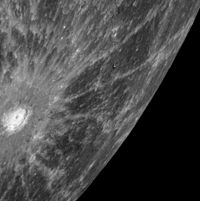- Debussy (crater)
-
Debussy (crater) 
Photo of Debussy crater by MESSENGERPlanet Mercury Coordinates 33°54′S 347°30′W / 33.9°S 347.5°WCoordinates: 33°54′S 347°30′W / 33.9°S 347.5°W Diameter 85 km[1] Eponym Claude Debussy[1] Debussy is a rayed impact crater on Mercury, which was discovered in 1969 by low resolution ground based radar observations obtained by the Goldstone Observatory.[2] Later in 1990–2005 it was imaged in more detail by the Arecibo Observatory. The crater was initially known as the feature A.[3] The bright appearance of rays in the radar images indicates that the crater is geologically young, because fresh and rough surfaces of young impact craters are good scatterers of radio waves.[3]
Debussy is named after Claude Debussy (1862–1918), one of the most important French composers, who worked in the field of the impressionist music.[1] It has a diameter of about 85 km, while the rays extend hundreds of kilometers, covering much of the southern hemisphere.[2] The ray system of Debussy is the second most prominent on Mercury after that of Hokusai.[3]
This crater is a prominent feature in the first photograph ever taken from Mercury orbit, taken on March 29, 2011 by the MESSENGER probe, pictured at right.
References
- ^ a b c "Ten Craters On Mercury Receive New Names". SpaceDaily. http://www.spacedaily.com/reports/Ten_Craters_On_Mercury_Receive_New_Names_999.html. Retrieved March 29, 2010.
- ^ a b "PIA11371: "A" Spectacular Rayed Crater". NASA. October 6, 2008. http://photojournal.jpl.nasa.gov/catalog/PIA11371. Retrieved March 30, 2010.
- ^ a b c Harmon, John K.; Slade, Martin A.; Butler, Bryan J.; et al., J; Rice, M; Campbell, D (2007). "Mercury: Radar images of the equatorial and midlatitude zones". Icarus 187 (2): 374–405. Bibcode 2007Icar..187..374H. doi:10.1016/j.icarus.2006.09.026.

This article about the planet Mercury is a stub. You can help Wikipedia by expanding it.

